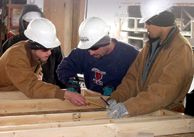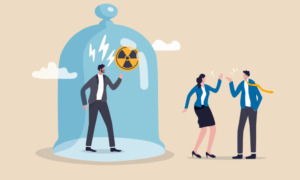By Ed Finkel
Bloomington, Ill.—Construction contractor Jason Wallace heard an unexpected knock at his front door one day a couple of years ago and got a big surprise when he opened it: There stood Cherie Pierce, director of alumni programming and housing services for YouthBuild McLean County – a program that Wallace participated in as a teenager in the mid-1990s. 
“She said, ‘Hey, what’s up? We ain’t heard from you in a while,’ ” Wallace recalls as he shouts over the whir of power tools and thwacking of hammers in the lot behind the agency’s modest offices, where YouthBuild kids are building playhouses. “I had just sort of lost touch with them for a little bit, and she actually found my address and came by.”
Wallace’s door is not the only one Pierce has knocked on to track down former participants in YouthBuild, which appears to be as active as any youth-serving agency at doing what many wish to do better: finding their alumni.
Tracking participants after they leave a program is usually difficult, time-consuming and expensive. Traditionally the province of universities and private prep schools, alumni-relations efforts appear to have escalated among youth agencies over the past several years. The payoffs include getting donations of time and money from alumni, along with glowing testimonials, and gathering evidence to show funders that the programs have long-term impacts.
“Because of the statistics that we’re able to keep, we can prove that what we do works, and what we do works over a long period of time,” Pierce says. “That’s what funders want to see: What do you do, does it work, and if so, how can we tell that?” Alumni outreach has enabled the Boys & Girls Clubs of America to tell funders that it literally saves youths’ lives, and provided a 4-H program in West Virginia with $350,000 to rebuild a damaged pool. It has taken those agencies beyond the typical, anecdotal evidence provided by a handful of alumni who drop in to say they’re doing well.
Committing Resources
Long-term follow-up on youth-oriented programs has primarily been the province of academic and other third-party researchers until recent years. Perhaps the gold standard in such longitudinal studies is the Perry Preschool Program, a High Scope Educational Research Foundation effort that has spent four decades OK and that the impact was not just temporary.” Her agency participated in the same national YouthBuild alumni study as McLean County, Ill. – which found that alumni reported engaging in behaviors such as alcohol use, drug use and criminal activities less often after YouthBuild participation than they had before.
In McLean County, Pierce says her agency cites the survey findings when applying for funding and uses them to figure out which alumni needs to focus on, such as access to higher education.
Krichko of B&GCA’s Southeastern Michigan affiliate says that when alumni are contacted, “seven out of 10 times, they’d like to make a donation or come to the club and help out, coach a sport as a volunteer, or become involved with a special event.” The B&GCA really saw the value of reaching alumni when it commissioned a formal survey of about 1,000 of them in 1999. “Fifty-two percent said the club literally or figuratively saved their life. That’s pretty powerful,” says McElroy, the vice president of marketing communications.
The survey, conducted by Louis Harris & Associates, is used in communications to parents, community leaders and donors, McElroy says, “because we believe that alumni are the people who can speak most effectively to the importance of the Boys & Girls Club experience in young lives.”
The BBBS feels the same about its alumni. Marketing vice president Palley cites St. Louis Police Lt. Anthony Carter, who runs a mentoring program and spoke last June at a New York City event called the One Vision Dinner, part of a national conference for corporate leaders and donors. He described how the program had helped to change his life as a youth.
“Nothing I could write in any marketing materials could ever be more powerful that seeing him stand up and burst into tears when his [big brother] appeared,” Palley says. “Alumni know what your program is about, they are mission-committed, they know the power of the model. Our alumni are living proof that our program works.”






























